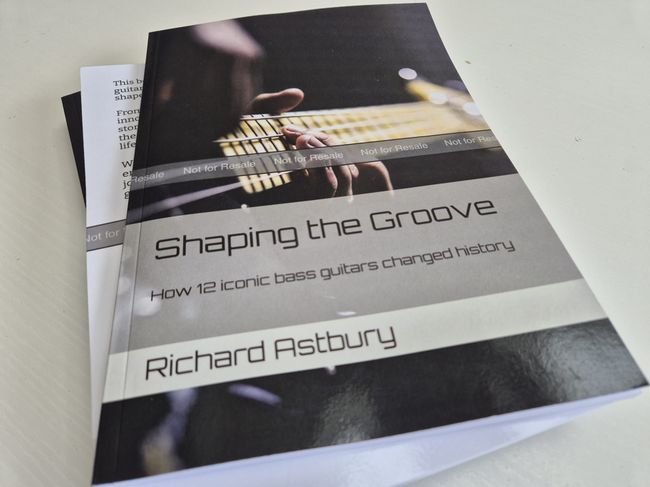Shaping the Groove: A book about bass guitar design
🚀 Announcing Shaping the Groove – A book about Bass Guitar Design 🎸

Ever wondered why the classic Fender bass designs have stood the test of time? I did too! When I went looking for a book that really explored the story behind these iconic instruments, I couldn’t find one that focused on what makes them so special. So, I (and ChatGPT) decided to dive in myself—not to write a complete history, but to shine a spotlight on 12 legendary basses that changed the game.
Here are the basses featured in the book:
- Fender Precision Bass (1951)
- Höfner 500/1 Violin Bass (1956)
- Fender Precision Bass Redesign (1957)
- The Fender Jazz Bass (1960)
- Rickenbacker 4001 (1961)
- Gibson Thunderbird (1963)
- Alembic Series I (1971)
- Music Man Stingray (1976)
- The Steinberger L-2 (1980)
- Warwick Thumb (1995)
- Dingwall Combustion (2000)
- Sadowsky Metro Series (2010)
Exert from the first chapter:
THE ORIGINS OF THE BASS GUITAR: A JOURNEY FROM UPRIGHT TO ELECTRIC
The bass guitar as we know it today is a cornerstone of modern music, anchoring rhythm and harmony across genres. However, its journey begins long before its electric counterpart took center stage. To fully appreciate the evolution of the bass guitar, it’s essential to understand the role of its predecessor—the double bass—and the challenges musicians faced with this instrument in the context of its time
THE DOUBLE BASS: FOUNDATION OF HARMONY AND RHYTHM
The double bass, also known as the upright bass or contrabass, emerged in the 16th century as the largest and lowest-pitched member of the violin family. By the 18th and 19th centuries, it had become an indispensable part of orchestras, chamber ensembles, and later, jazz bands. Its deep, resonant tones provided the harmonic foundation for ensembles, allowing other instruments to soar melodically above its steady grounding. In orchestras, it reinforced the lower strings and added weight to the harmonic structure, while in jazz, it became a rhythmic pulse, often plucked in a walking bass style to drive the music forward.
Despite its essential role, the double bass presented significant challenges. Its size made it cumbersome to transport, and its lack of amplification limited its effectiveness in larger, louder ensembles or outdoor performances. Players often struggled to be heard, especially as music evolved into louder and more dynamic styles in the late 19th and early 20th centuries. These limitations sparked the search for a more portable, louder alternative that could fulfill the same foundational role.
EARLY INNOVATIONS: BRIDGING THE GAP
One of the earliest attempts to address these challenges was the tubular bass, patented by August Heckel in 1912. Shaped like a tuba and designed to produce low frequencies with greater portability, it was an intriguing concept but ultimately impractical. Its awkward design and lack of widespread appeal meant it never gained traction.
Meanwhile, the double bass continued to evolve within its limitations. In the burgeoning jazz scene of the early 20th century, players like Jimmy Blanton revolutionized its role, bringing melodic fluency and rhythmic complexity to the instrument. These innovations showcased the double bass’s versatility but also highlighted the need for a more practical solution for bassists in increasingly amplified settings.
THE BIRTH OF THE ELECTRIC BASS
The search for a portable and amplified bass solution gained momentum in the 1930s with Paul Tutmarc’s invention of the Audiovox Model 736. This solid-body electric bass was a bold departure from the upright bass, featuring a horizontal design similar to a guitar. It allowed players to stand or sit comfortably while playing and could be amplified to match the volume of other instruments. Despite its innovation, the Audiovox Model 736 was ahead of its time and failed to achieve widespread adoption.
It wasn’t until the early 1950s that Leo Fender’s Fender Precision Bass brought the concept to life in a way that resonated with musicians and the music industry. Fender’s design was revolutionary not just for its practicality but also for its impact on the sound and structure of modern music. The Precision Bass was lighter, easier to play, and, crucially, amplified, making it ideal for the louder, evolving soundscapes of post-war music. It quickly became the go-to instrument for bassists in genres ranging from rock and roll to funk, jazz, and beyond. We will expand on this in the next chapter, as the Precision Bass remains an iconic instrument that not only revolutionized bass playing but also set the standard for all modern bass guitar designs. Its influence can be seen in nearly every electric bass that followed, cementing its place as a timeless cornerstone of music history.